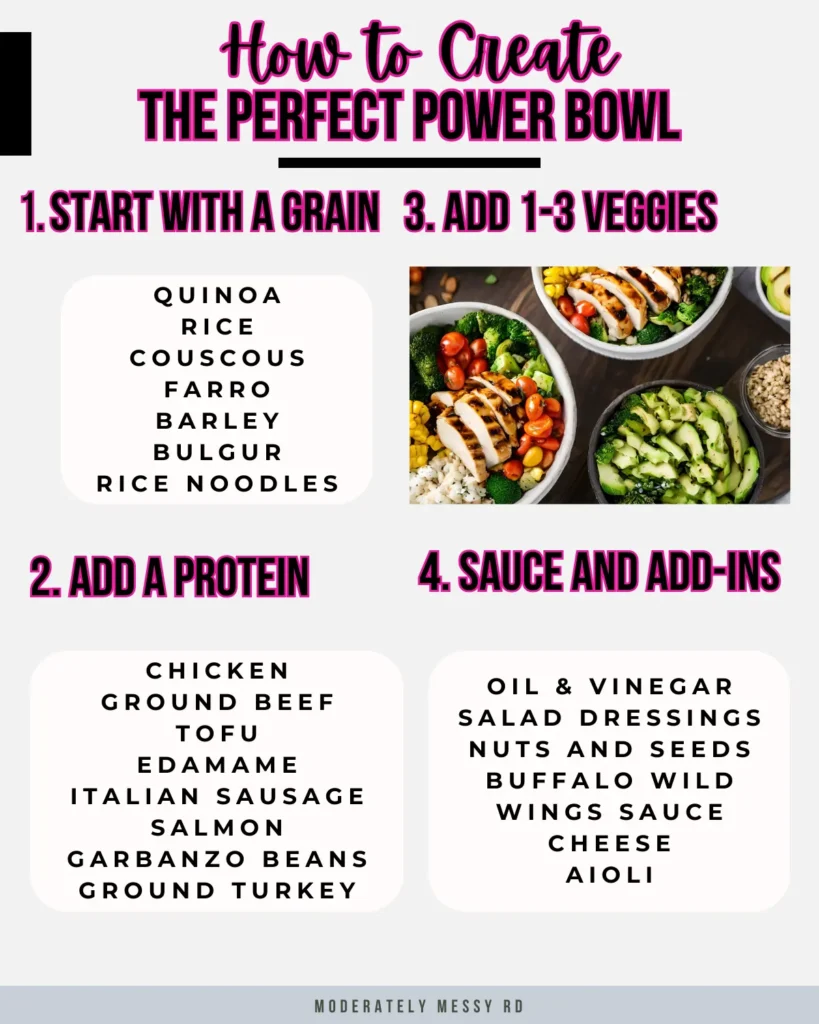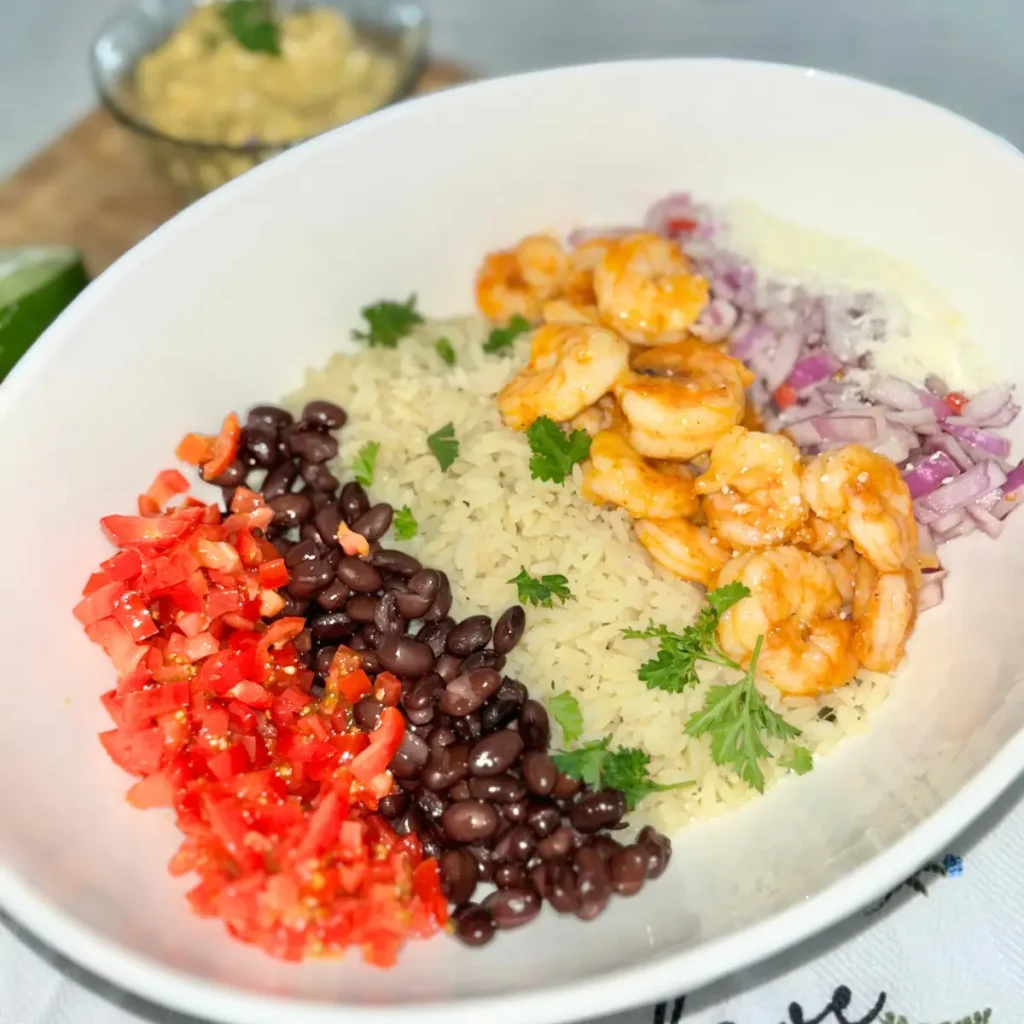The power bowl is the queen of throw together meals. Whether you’re short on time, or sick of meal planning every week- power bowls are quick, easy, and full of nutrients as long as you understand the basis of them. This post consists of not only recipe ideas, but includes the fundamentals of how to create your own based on you and your family’s preferences.

Home-cooked meals are often healthier than eating out or ordering takeout. When we cook our own food, we can control portion sizes as well as the calorie, sodium, and nutrient content.
This post is meant to empower and educate, so you don’t need to meal plan all the time. That way, you can throw together the perfect power bowl with food you have available on any given night.
The Basis of a Healthy Power Bowl
Each bowl should contain a high quality protein, carbohydrate, and at least one vegetable (or fruit), the basics of a well-balanced meal.
You can then decide what type of bowl you’re craving for that night. It could be Mexican. It could be Italian. What about Mediterranean? The options are endless.
Knowing these three components will make the meal creation much easier. If you don’t have a plan for dinner one night, you can select which type of bowl you create based on what type of meat you have thawed, what vegetables need to be used the quickest, or just what you’re in the mood for.

Start with a Grain
Carbohydrates are the primary source of energy for our bodies, and the base of the power bowl. The art of throwing together a bowl requires some staples in your pantry. Ensure you have a variety of grains available at your disposal.
Below are some examples of grains along with their nutrient profiles for inspiration.
Grain Ideas
Rice – Most bowls use rice as the base. The 90-second microwaveable pouches can be great for convenience. Brown rice can be a healthier option than white rice as it contains more fiber and magnesium, but nutritionally they are relatively comparable.
Quinoa – This gluten-free option is considered a “complete protein”, which is usually only found in animal products. It is a good source of folate, magnesium, zinc, and iron. This power grain contains quercetin and kaempferol, which are well-studied flavonoids that help protect our cells from free radicals (1). Consuming foods that contain these compounds can decrease your risk of certain diseases, as well as decrease mortality.
Barley – A whole grain which contains even higher amounts of fiber than quinoa. The cooking time is longer than quinoa, but offers a different texture to change things up.
Farro- Compared to white rice and other refined grains, it contains higher amounts of niacin, magnesium, zinc, and fiber. Like barley, it has a chewy texture and nutty flavor.
Couscous/Pearled Couscous – A delicious option with a quick cooking time. It also contains a high amount of selenium.
Pasta – There are many options to choose from! Orzo is one of my favorite staples for power-bowls. Banza chickpea pasta or Barilla Chickpea Rotini are heathier options nutrient-wise.
Rice Noodles – While nutritionally comparable to most other refined grains, they’re a great option for an Asian-inspired bowl.

Protein
Proteins are the building blocks of life, contained in every cell of the human body (2). Animal proteins are considered “complete” proteins and contain all essential amino acids. Plant proteins are “incomplete”, as they do not contain all of the amino acids. For example, both rice and beans contain protein but together they make a “complete” protein.
Examples of protein for your bowls could be chicken, steak, ground beef, sausage, salmon, ground turkey, ground pork, eggs, black beans, garbanzo beans, tofu, edamame, and lentils.
Chopped nuts, like walnuts, add texture and crunch to power-bowls while also containing protein.
Vegetables
The more vegetables you add to your bowl the more nutritious it will likely be. Adding a variety of color will provide different nutrients, as each color provides different phytonutrients. Red is rich in lycopene, whereas orange and yellow contain beta-carotene.
Choose whatever vegetables you have on hand, and if you have the time, select at least two for the health benefits. Frozen veggies are just as healthy as fresh!
Different Variations of Power Bowls
It’s easy to change up the flavor profile if you have the right ingredients on hand. I like to buy sauces from the grocery store to keep in the fridge or pantry to make it easy to throw together whatever bowl I am craving. You could also keep certain spices or seasoning packets on hand for a simple way to add variety to your power bowl.
Convenience items like these may be higher in salt and sugar, but help make power bowls EASY for anyone to do, on any timeframe. Do you have any of these items just sitting in your pantry or fridge that you can add in?
Example Variation Items and Add-Ons
Mediterranean
– Feta Cheese
– Olives
– Red Pepper Sauce
– Garlic Sauce
– Crushed Pita Chips
– Mediterranean Herb and Spice Blend
– Hummus
Asian
– Chili Garlic Sauce
– Sweet Chili Sauce
– Soy Sauce + Honey
– Chopped Walnuts
– Sriracha
– Teriyaki Sauce
– PF Chang’s Kung Pao Sauce
American/Italian
– Ranch Seasoning
– Pesto
– Buffalo Wild Wings Sauce (Parmesan Garlic, Buffalo)
– Garlic Aoli (or Truffle, Lemon Aioli, etc.)
– Boursin Cheese
Mexican
– Shredded Cheese
– Salsa
– Guacamole Salsa
– Chopped Walnuts
– Hot Sauce
– Chipotle Aioli
– Taco Seasoning
Simple Power Bowl Recipes
Feel free to get as creative and complex as you want, but for these recipes I focused on simple. Whether you’re a tired new mom with a baby, or a mother with school-aged children involved in activities – I hope these recipes inspire you to cook more, and eat out less.
Easy, healthy meals are attainable at all stages of life – even if they’re just thrown together at the last minute!

This Mediterranean Grain Bowl is a staple in our household, my go-to meal whenever I don’t feel like looking up new recipes for the week. It’s just a meal that feels fresh and healthy – with the antioxidants from the veggies, fiber from the quinoa and beans, and healthy fats from the olive oil and chopped walnuts.
More Power Bowl Recipes

— Chicken Burrito Protein Bowl from Feel Good Foodie.
— Easy and Healthy Shrimp Taco Bowl (shown above).
— Greek Chicken Power Bowl from Creme de la Crumb.
— Healthy Buffalo Chicken Power Bowl from Laura Fuentes.
— Veggie Power Bowl from Love & Lemons.
— Salmon Power Bowl from EatingWell.
— Easy Beef Burrito Bowl from Everyday Eileen.
— Asian Quinoa Power Bowl with Ginger Miso Dressing from Fit Living Eats.
Related Posts:
— Protein Bowl Recipes
— 92 Lazy Sunday Dinner Ideas
Hope You Enjoyed the Power Bowl Recipes!
The versatility of power bowls allows you to experiment with various flavors, textures, and nutrient-rich ingredients, making each creation a unique experience. They offer a convenient and satisfying way to nourish your body.
I aim to cook a homemade meal 5 days a week, and I make one of these power bowl recipes at least one of those days. It makes my life easier with two young girls.
What is the hardest part of meal planning and cooking for you? Did this post make any of it more manageable?
